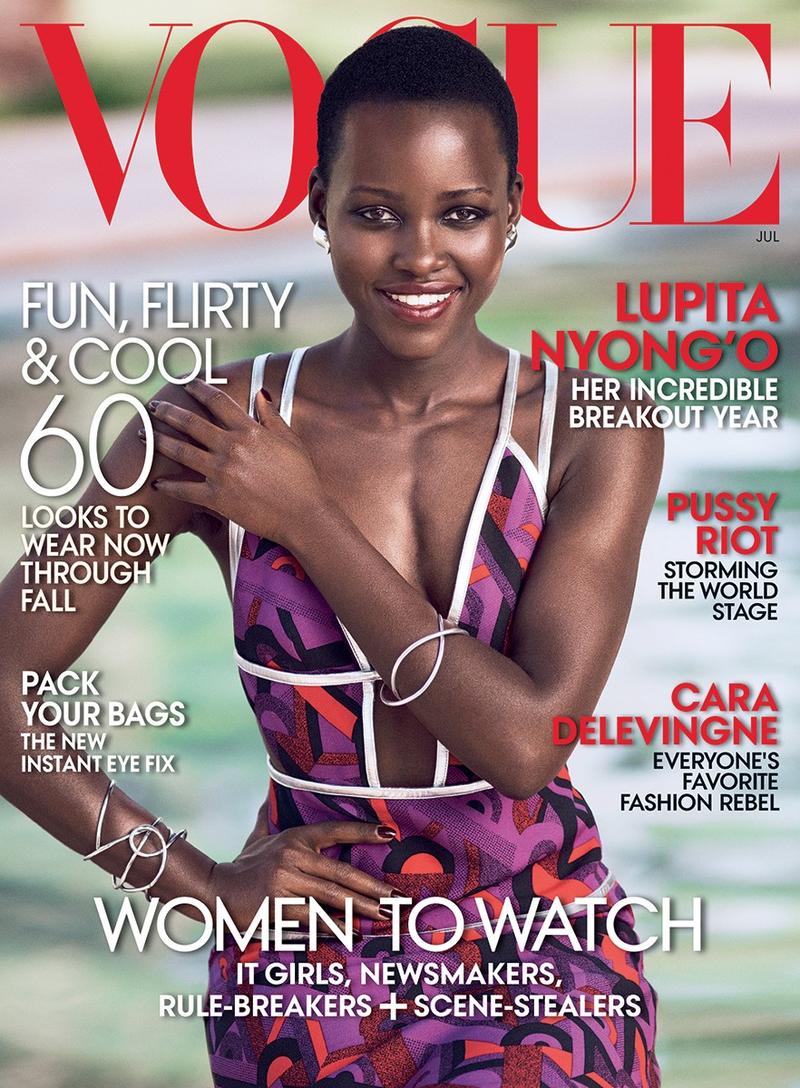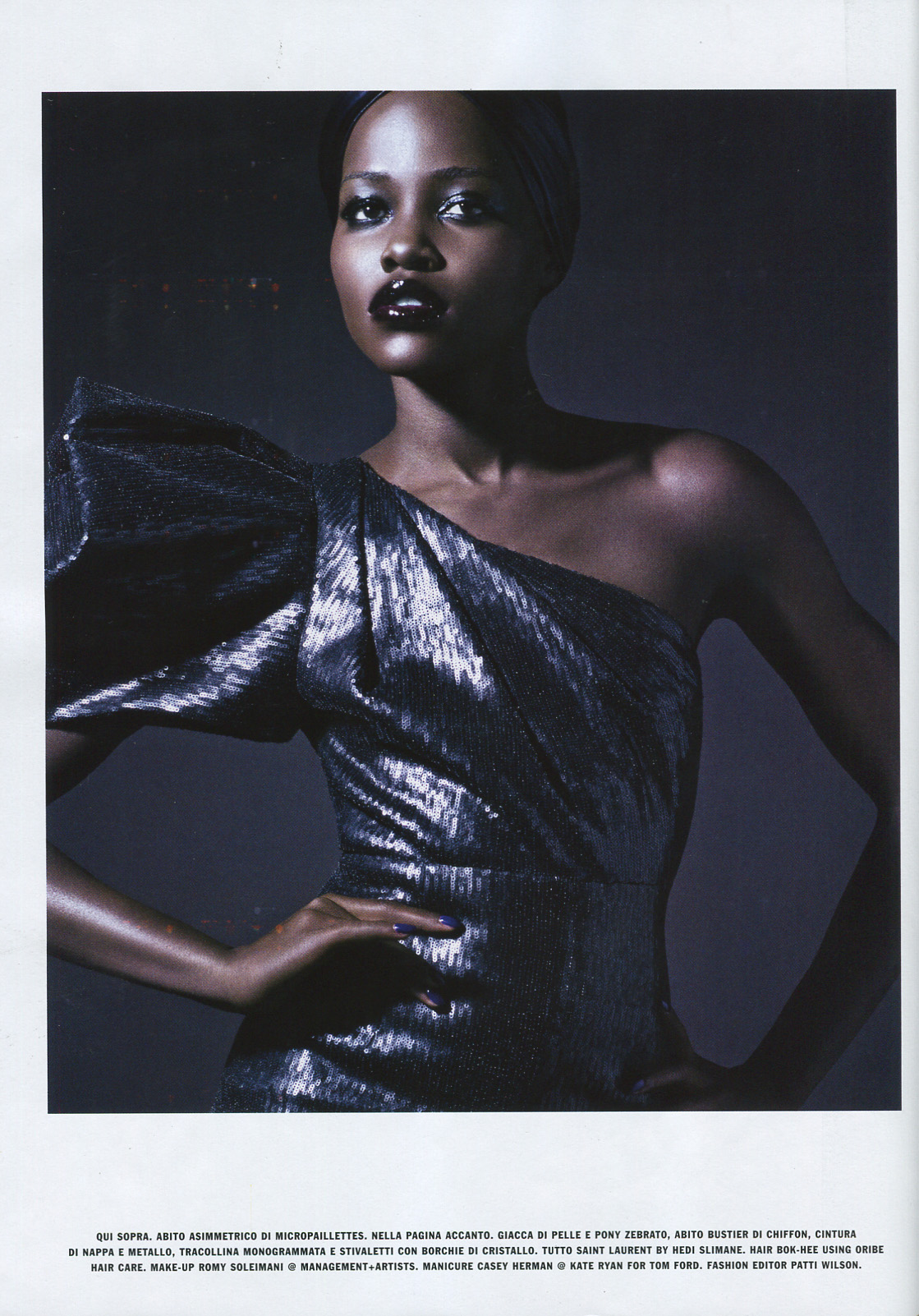Lupita Nyong'O - Actrice Kenyane


Agent
Hylda
Queally,
Creative
Artists Agency,
9830
Wilshire Blvd.,
Beverly Hills,
CA 90212
Vogue Usa
Juillet 2014
Mikael Jansson
Vogue Italie
Février 2014
Tom Munro
Marrakech in May is unseasonably tagine-hot. Hapless tourists are being felled by sunstroke merely from sauntering across the city’s pulsing medina square, which is all but abandoned by the native food and trinket traders, snake-charmers, and storytellers who will throng it in the desert cool of evening. But in the oasis sanctuary of the Ksar Char-Bagh, all is balmy dolce far niente. A luxe spa hostelry built in imitation of a castle-like fort in the middle of the Palmeraie, it has crenellated towers that hide a private dipping pool and afford views down to a central marbled courtyard modeled on Granada’s Moorish Alhambra, and across the palm groves to the distant Atlas Mountains. Guests are lounging poolside in the shade of an allée of date palms, seemingly oblivious of the Academy Award–winning deity in their midst, who is the focus of the Vogue cover shoot in full fluster around them. Lupita Nyong’o is cucumber-cool, as beautiful and hieratic as an ancient Egyptian statue of a cat goddess, dressed in Prada’s magenta Deco-print dress licked with silver that is dazzling against her luminous skin. Lupita instinctively falls into graceful attitudes; she can’t help herself. “She knows the camera, she knows her angles,” notes an approving Phyllis Posnick, Vogue’s Executive Fashion Editor, who, it should be noted, does not suffer fools gladly but is in some kind of awe of this particular subject. It is easy to see why. Lupita, 31, is as preternaturally poised as a prewar debutante, with a carefully modulated, cut-crystal accent and a quaint use of English to match. When she discusses one of the most harrowing scenes in the infinitely harrowing 12 Years a Slave, Steve McQueen’s magisterial movie in which she made her unforgettable screen debut as the tormented slave girl Patsey, she describes her character, delicately, as being “completely disrobed.” At the BAFTAs at London’s Royal Opera House in February, I happened to follow Lupita’s blindingly flash-lit entrance on the red carpet as she artfully manipulated the emerald-green organza Dior ball gown billowing around her. There was nothing in this swanlike apparition to suggest how stressful the relentless awards-show circuit can be. “Still waters run deep,” she explains with an enigmatic smile. In all, Lupita attended 60-some promotional events during a grueling five-month odyssey that began with the Toronto Film Festival in early September 2013 (where she first blazoned the promise of fashion stardom in Prada’s white jersey goddess dress, trellised with golden sequins). Small wonder that The New York Times’s Guy Trebay noted the “military precision” with which her management and stylists approached the campaign to conquer the red carpet and burn Lupita’s image into the collective consciousness—garnering her, among other things, a lucrative contract with Lancôme. (As Isabella Rossellini, the international face of the brand for more than a decade, beginning in 1983, describes it, “Having this contract is winning the lottery” and provided her with “the freedom to make only the films that I liked and not the films I didn’t.”) Lupita appreciates the fact that Lancôme’s brand ambassadors, who currently include Julia Roberts, Kate Winslet, and Penélope Cruz, “are very different, unique women—it’s not about conforming to an already established idea of what is beautiful, and I like that.” In her meetings with the beauty house’s executives, she echoed powerful sentiments she expressed in a speech earlier in the year at the Essence Black Women in Hollywood Luncheon. “I remember a time when I too felt unbeautiful,” she told the audience that day, and described the sensation of having a flower bloom inside her when the Sudanese-born Alek Wek appeared on the modeling scene in the mid-nineties. Over dinner at Le Tobsil, a spice-colored riad restaurant in the medina, she tells me, “I felt how valuable and vital such representation is.” As we are serenaded by the hypnotic chant of the Gnawa musicians in the adjoining courtyard, I suggest to Lupita that she must have had a completely surreal year. “Indeed I did,” she says, laughing. “It just feels like the entertainment industry exploded into my life. People who seemed so distant all of a sudden were right in front of me and recognizing me—before I recognized them!” Her first real intimation that her life was changing—probably forever—came after the SAG Awards in January, when she arrived late one night at the airport and was mobbed by paparazzi. “For a split second I looked behind me to see who they were flashing at—and it was me!” she remembers. “That was, I think, the beginning of the end of my anonymity.” Though, as she recalls with a laugh, she lived for three years as a student in pants and a sweatshirt, Lupita has always enjoyed fashion. Growing up in Kenya, she designed many of her own clothes “because it was cheaper than buying retail,” including her own prom dress when she graduated from the all-boys high school she attended in Nairobi—girls were accepted only in two advanced-placement classes. “It was a velvet miniskirt with a matching little top and an iridescent silver translucent fabric that flowed to the ground,” she remembers. “It was kind of ridiculous, but it was fabulous at the time.” Lupita realized that she needed a more considered approach to her fashion choices as she prepared for the formidable season of appearances for 12 Years a Slave. She had worked with and befriended Michelle Dockery (Downton Abbey’s Lady Mary) on Non-Stop (a rollicking suspense vehicle for Liam Neeson that was released two days before the Academy Awards, with Lupita—in what more than one critic described as a meager role—as a flight attendant alongside Dockery). Dockery introduced her to her stylist, Micaela Erlanger, a protégée of the late Annabel Tollman, who helped shape the red-carpet personas of Scarlett Johansson and Mary-Kate and Ashley Olsen, among others. Lupita arrived for their first meeting armed with a Pinterest board of fashion ideas that appealed to her: “Bold color, interesting print, interesting silhouette—simple but architectural and feminine,” Erlanger remembers. “Elegance, but with a sense of humor.” The pair proceeded to meet for “epic six-hour fittings,” says Lupita. “It’s a job; it’s work, you know!” she tells me. “We’d just try, try, try, try, try, try, try. At first it was very daunting, but I ended up really having fun with it.” Their choices have run the gamut from Christopher Kane and Sacai to custom Prada and Chanel Haute Couture. Most times, she adds, “especially for the bigger awards, the dress let me know it was going to be worn. It’s quite scary when you fall in love with a dress, because it’s nothing to do with your brain. It’s like a gut reaction.” The caped scarlet Ralph Lauren gown for the Golden Globes was a case in point: “We got goose bumps,” remembers Erlanger of that fitting. “I told her, ‘This is going to be a game-changer.’ And it was.” Lupita was cast in Miu Miu’s spring campaign alongside Elizabeth Olsen, Elle Fanning, and Bella Heathcote, and attended the label’s fashion show in Paris, dressed in a collared burgundy sweater under the sort of stiff little coat that Britain’s royal children have traditionally worn—the prim Good Girl foil to her front-row neighbor, Rihanna, who was working an eighties banjee-girl look in a runway-fresh Prada shearling coat, a plunging décolleté, and a Cleopatra bob.